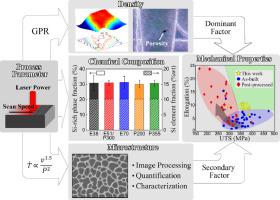当前位置:
X-MOL 学术
›
Acta Mater.
›
论文详情
Our official English website, www.x-mol.net, welcomes your
feedback! (Note: you will need to create a separate account there.)
Machine-learning assisted laser powder bed fusion process optimization for AlSi10Mg: New microstructure description indices and fracture mechanisms
Acta Materialia ( IF 8.3 ) Pub Date : 2020-12-01 , DOI: 10.1016/j.actamat.2020.10.010 Qian Liu , Hongkun Wu , Moses J. Paul , Peidong He , Zhongxiao Peng , Bernd Gludovatz , Jamie J. Kruzic , Chun H. Wang , Xiaopeng Li
Acta Materialia ( IF 8.3 ) Pub Date : 2020-12-01 , DOI: 10.1016/j.actamat.2020.10.010 Qian Liu , Hongkun Wu , Moses J. Paul , Peidong He , Zhongxiao Peng , Bernd Gludovatz , Jamie J. Kruzic , Chun H. Wang , Xiaopeng Li

|
Abstract In this study, a machine-learning approach based on Gaussian process regression was developed to identify the optimized processing window for laser powder bed fusion (LPBF). Using this method, we found a new and much larger optimized LPBF processing window than was known before for manufacturing fully dense AlSi10Mg samples (i.e., relative density ≥ 99%). The newly determined optimized processing parameters (e.g., laser power and scan speed) made it possible to achieve previously unattainable combinations of high strength and ductility. The results showed that although the AlSi10Mg specimens exhibited similar Al-Si eutectic microstructures (e.g., cell structures in fine and coarse grains), they displayed large difference in their mechanical properties including hardness (118 - 137 HV 10), ultimate tensile strength (297 - 389 MPa), elongation to failure (6.3 - 10.3%), and fracture toughness (9.9 - 12.7 kJ/m2). The underlying reason was attributed to the subtle microstructural differences that were further revealed using two newly defined morphology indices (i.e., dimensional-scale index Id and shape index Is) based on several key microstructural features obtained from scanning electron microscopy images. It was found that in addition to grain structure, the sub-grain cell size and cell boundary morphology of the LPBF fabricated AlSi10Mg also strongly affected the mechanical properties of the material. The method established in this study can be readily applied to the LPBF process optimization and mechanical properties manipulation of other widely used metals and alloys or newly designed materials.
中文翻译:

AlSi10Mg 的机器学习辅助激光粉末床融合工艺优化:新的微观结构描述指标和断裂机制
摘要 在本研究中,开发了一种基于高斯过程回归的机器学习方法来确定激光粉末床融合 (LPBF) 的优化处理窗口。使用这种方法,我们发现了一个新的和更大的优化 LPBF 处理窗口,比以前已知的用于制造完全致密的 AlSi10Mg 样品(即相对密度≥ 99%)。新确定的优化加工参数(例如激光功率和扫描速度)使得以前无法实现的高强度和延展性组合成为可能。结果表明,尽管 AlSi10Mg 试样表现出相似的 Al-Si 共晶微观结构(例如,细晶粒和粗晶粒的晶胞结构),但它们的力学性能差异很大,包括硬度 (118 - 137 HV 10)、极限抗拉强度 (297 - 389 兆帕), 断裂伸长率 (6.3 - 10.3%) 和断裂韧性 (9.9 - 12.7 kJ/m2)。根本原因归因于细微的微观结构差异,根据从扫描电子显微镜图像获得的几个关键微观结构特征,使用两个新定义的形态指数(即尺寸尺度指数 Id 和形状指数 Is)进一步揭示了细微的微观结构差异。结果表明,除了晶粒结构外,LPBF 制造的 AlSi10Mg 的亚晶胞尺寸和胞界形态也强烈影响材料的机械性能。本研究中建立的方法可以很容易地应用于其他广泛使用的金属和合金或新设计的材料的 LPBF 工艺优化和机械性能操纵。根本原因归因于细微的微观结构差异,根据从扫描电子显微镜图像获得的几个关键微观结构特征,使用两个新定义的形态指数(即尺寸尺度指数 Id 和形状指数 Is)进一步揭示了细微的微观结构差异。结果表明,除了晶粒结构外,LPBF 制造的 AlSi10Mg 的亚晶胞尺寸和胞界形态也强烈影响材料的机械性能。本研究中建立的方法可以很容易地应用于其他广泛使用的金属和合金或新设计的材料的 LPBF 工艺优化和机械性能操纵。根本原因归因于细微的微观结构差异,根据从扫描电子显微镜图像获得的几个关键微观结构特征,使用两个新定义的形态指数(即尺寸尺度指数 Id 和形状指数 Is)进一步揭示了细微的微观结构差异。结果表明,除了晶粒结构外,LPBF 制造的 AlSi10Mg 的亚晶胞尺寸和胞界形态也强烈影响材料的机械性能。本研究中建立的方法可以很容易地应用于其他广泛使用的金属和合金或新设计的材料的 LPBF 工艺优化和机械性能操纵。维尺度指数 Id 和形状指数 Is) 基于从扫描电子显微镜图像中获得的几个关键微观结构特征。结果表明,除了晶粒结构外,LPBF 制造的 AlSi10Mg 的亚晶胞尺寸和胞界形态也强烈影响材料的机械性能。本研究中建立的方法可以很容易地应用于其他广泛使用的金属和合金或新设计的材料的 LPBF 工艺优化和机械性能操纵。维尺度指数 Id 和形状指数 Is) 基于从扫描电子显微镜图像中获得的几个关键微观结构特征。结果表明,除了晶粒结构外,LPBF 制造的 AlSi10Mg 的亚晶胞尺寸和胞界形态也强烈影响材料的机械性能。本研究中建立的方法可以很容易地应用于其他广泛使用的金属和合金或新设计的材料的 LPBF 工艺优化和机械性能操纵。LPBF 制造的 AlSi10Mg 的亚晶胞尺寸和晶胞边界形态也强烈影响材料的机械性能。本研究中建立的方法可以很容易地应用于其他广泛使用的金属和合金或新设计的材料的 LPBF 工艺优化和机械性能操纵。LPBF 制造的 AlSi10Mg 的亚晶胞尺寸和晶胞边界形态也强烈影响材料的机械性能。本研究中建立的方法可以很容易地应用于其他广泛使用的金属和合金或新设计的材料的 LPBF 工艺优化和机械性能操纵。
更新日期:2020-12-01
中文翻译:

AlSi10Mg 的机器学习辅助激光粉末床融合工艺优化:新的微观结构描述指标和断裂机制
摘要 在本研究中,开发了一种基于高斯过程回归的机器学习方法来确定激光粉末床融合 (LPBF) 的优化处理窗口。使用这种方法,我们发现了一个新的和更大的优化 LPBF 处理窗口,比以前已知的用于制造完全致密的 AlSi10Mg 样品(即相对密度≥ 99%)。新确定的优化加工参数(例如激光功率和扫描速度)使得以前无法实现的高强度和延展性组合成为可能。结果表明,尽管 AlSi10Mg 试样表现出相似的 Al-Si 共晶微观结构(例如,细晶粒和粗晶粒的晶胞结构),但它们的力学性能差异很大,包括硬度 (118 - 137 HV 10)、极限抗拉强度 (297 - 389 兆帕), 断裂伸长率 (6.3 - 10.3%) 和断裂韧性 (9.9 - 12.7 kJ/m2)。根本原因归因于细微的微观结构差异,根据从扫描电子显微镜图像获得的几个关键微观结构特征,使用两个新定义的形态指数(即尺寸尺度指数 Id 和形状指数 Is)进一步揭示了细微的微观结构差异。结果表明,除了晶粒结构外,LPBF 制造的 AlSi10Mg 的亚晶胞尺寸和胞界形态也强烈影响材料的机械性能。本研究中建立的方法可以很容易地应用于其他广泛使用的金属和合金或新设计的材料的 LPBF 工艺优化和机械性能操纵。根本原因归因于细微的微观结构差异,根据从扫描电子显微镜图像获得的几个关键微观结构特征,使用两个新定义的形态指数(即尺寸尺度指数 Id 和形状指数 Is)进一步揭示了细微的微观结构差异。结果表明,除了晶粒结构外,LPBF 制造的 AlSi10Mg 的亚晶胞尺寸和胞界形态也强烈影响材料的机械性能。本研究中建立的方法可以很容易地应用于其他广泛使用的金属和合金或新设计的材料的 LPBF 工艺优化和机械性能操纵。根本原因归因于细微的微观结构差异,根据从扫描电子显微镜图像获得的几个关键微观结构特征,使用两个新定义的形态指数(即尺寸尺度指数 Id 和形状指数 Is)进一步揭示了细微的微观结构差异。结果表明,除了晶粒结构外,LPBF 制造的 AlSi10Mg 的亚晶胞尺寸和胞界形态也强烈影响材料的机械性能。本研究中建立的方法可以很容易地应用于其他广泛使用的金属和合金或新设计的材料的 LPBF 工艺优化和机械性能操纵。维尺度指数 Id 和形状指数 Is) 基于从扫描电子显微镜图像中获得的几个关键微观结构特征。结果表明,除了晶粒结构外,LPBF 制造的 AlSi10Mg 的亚晶胞尺寸和胞界形态也强烈影响材料的机械性能。本研究中建立的方法可以很容易地应用于其他广泛使用的金属和合金或新设计的材料的 LPBF 工艺优化和机械性能操纵。维尺度指数 Id 和形状指数 Is) 基于从扫描电子显微镜图像中获得的几个关键微观结构特征。结果表明,除了晶粒结构外,LPBF 制造的 AlSi10Mg 的亚晶胞尺寸和胞界形态也强烈影响材料的机械性能。本研究中建立的方法可以很容易地应用于其他广泛使用的金属和合金或新设计的材料的 LPBF 工艺优化和机械性能操纵。LPBF 制造的 AlSi10Mg 的亚晶胞尺寸和晶胞边界形态也强烈影响材料的机械性能。本研究中建立的方法可以很容易地应用于其他广泛使用的金属和合金或新设计的材料的 LPBF 工艺优化和机械性能操纵。LPBF 制造的 AlSi10Mg 的亚晶胞尺寸和晶胞边界形态也强烈影响材料的机械性能。本研究中建立的方法可以很容易地应用于其他广泛使用的金属和合金或新设计的材料的 LPBF 工艺优化和机械性能操纵。











































 京公网安备 11010802027423号
京公网安备 11010802027423号